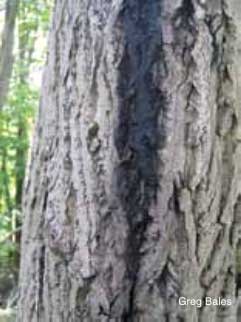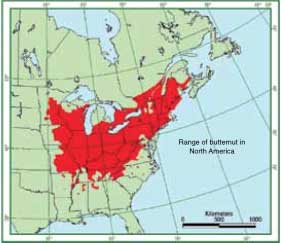Butternut Canker
Ophiognomonia clavigignenti-juglandacearum
December 2014
Constanza Maass
The Ophiognomonia clavigignenti-juglandacearum is an invasive species of fungus that infects the butternut trees and kills them by penetrating the phloem and progressing into bark and wood tissue. It has caused a decline in butternut trees by 80% in Ontario.
The butternut canker (Ophiognomonia clavigignenti-juglandacearum) is a non-indigenous pathogenic fungus that is rapidly increasing its threat to the butternut tree, a North American tree species. Ecosystems can be essentially changed when abundant tree species are eliminated, this is the effect that the butternut canker is having on the butternut tree (Loo, 2008). Butternuts are highly nutritious and are eaten by a wide variety of wildlife species and humans. As well, the butternut tree provides habitat for a lot of wildlife and was a valuable hardwood species used for furniture (Parks, 2014) The fungus is an important factor in the decline of the butternut tree and has left the remaining butternut trees isolated and sparsely distributed (Parks, 2014). Unlike other trees (for example, the American Chestnut) the butternut will not sprout from the root crown when the top is killed by cankers. Therefore, when a butternut canker disease destroys a population, the gene pool is lost forever and there is no possibility of reproduction (Campbell, 2002)
The origin of the fungus is not known but it is thought
likely to be non-indigenous in North America because of its sudden appearance, its aggressiveness
and the lack of genetic variability (Loo, 2008). In artificial inoculation studies of various
Juglans species, Japanese walnut (J. ailantifolia) and heartnut (J. ailantifolia
var. cordiformis), both Asian species, showed the highest levels of resistance. This piece of
evidence suggests it may have originated in Asia (Furnier, 1999).
Randomly amplified polymorphic DNA (RAPD) markers were used in an experiment to examine the genetic
variation in the fungus. The observed monomorphism of the
fungus in this experiment is consistent with the theory that it was introduced into North America
as a single isolate (Furnier, et al. 1999). It also suggests that if resistant butternut genotypes
are found, the pathogen will not likely be able to rapidly evolve genotypes that can attack them
(Furnier, et al. 1999). Therefore, once resistance is found, there is a very low chance that a
fungal isolate will arise that is capable of overcoming the host resistance (Furnier, et al. 1999).
The fungus usually starts on small branches and twigs in the crown, although it may also be observed on the trunk and near the root collar. The pathogen is very aggressive and has spread rapidly since it was first detected in 1967 (Loo, 2008). In the span of 15 years, the fungus has cause the decline of the butternut tree by 80% in Ontario (Loo, 2008). Because of its high mortality rate, the fungus has caused the butternut tree to be designated as an endangered species in Ontario (Canada).

Figure 1: Butternut stem with black discharge from butternut canker sites within the bark.
(Ontario Ministry of Natural Resources and Environment)
|

Figure 2: The range of butternut in North America. (Ontario Ministry of Natural Resources and Environment)
|
Taxonimic affiliation
Binomial name: Ophiognomonia clavigignenti-juglandacearum, kingdom: fungi, division: ascomycota, class: sordariomyectes, order: diaporthales, family: incertae sedis, genus: Ophiognomonia.
Life cycle
Butternut trees are infected by the the fungus through buds, lenticels, cracks in the bark and leaf scars. Cankers on twigs start to develop, normally this happens in the lower crown because the microclimatic conditions are most favourable here, branches in the lower crown tend to retain the moisture necessary for spore germination for longer periods of time compared to the upper crown (European and Mediterranean Plant Protection Organization). After the infection occurs, bark cell walls are degraded, resulting in a dark brown sticky residue and brown exudates. The fungal hyphae penetrate the phloem and progress into bark and wood tissue. Throughout the growing season, conidia develop beneath infected bark in sticky masses. Stromatal pegs lift and rupture the bark; conidia are extruded in cirri from pycnidia present among the hyphal pegs. (European and Mediterranean Plant Protection Organization)
Methods of Spread
The fungus occurs on butternut trees of all ages and on all sites. The infection can occur through buds, leaf scars, and wounds. Spores are dispersed by rain splash and wind in water droplets or as aerosols during rainfall. As well, in run-off water from infected branches and stems, and insects. A relative humidity of 95-100% was found to aid successful infection greatly. The result of the spread of the fungus into wounds of the butternut and other openings results in multiple stem cankers that lead to the death of the tree within at least 20 months (European and Mediterranean Plant Protection Organization). The spores of the pathogen require at least 16 hours of dew at 20 C to germinate on the bark of the butternut tree (European and Mediterranean Plant Protection Organization).
Morphology
The fungus forms a thin, dark brown-black stroma of many septates, branches mucelium beneath the outmost bark layer. There are hyphal pegs that arise from the stroma (European and Mediterranean Plant Protection Organization).
Habitat
This species has best growth in riparian areas, which is the interface between land and a river or stream, and rich upland forests, though it grows on dry outwash sands and gravels (Loo, 2008). The community and ecosystem structure is altered when the butternut tree is attacked by the pathogen. The opening of the canopy from the death of individual trees increases the amount of available light, nutrients, and moisture on the forest floor. This increases the populations of smaller species that normally grow below the butternut tree. (Sirococcus clavigignenti-juglandacearum Butternut Canker pathogen).
Control
As of recent, there is no effectively applied control against the fungus. Even if an effective fungicide or biocontrol agent were to be discovered, it would be difficult to apply due to the scattered distribution of susceptible trees and the many methods of spread of the pathogen. The only possibility of a successful control for this fungus is the selection of resistant forms. (European and Mediterranean Plant Protection Organization).
My Project
My University of Ottawa community engagement project consisted of doing research with two supervisors named Murray Inch and John Sankey, who volunteer at the Oak Valley Pioneer Park, on the butternut tree and the canker that infects it. I mainly conducted my research online and from books. I also did some field work, where I went to the Oak Valley Pioneer Park and visited the tree plantations. This park is a memorial to the Pioneers of Canada and a nut tree arboretum and research facility. Here, they have one of Ontario's three butternut archives that test for resistance to the butternut canker.
During my trip to the Oak Valley Pioneer Park, I looked at butternut trees that had been grafted onto black walnut tree roots. I analyzed whether this process had helped the butternut trees gain resistance to the canker. First, I learned to identify the difference between the black walnut and the butternut tree. One way to do this is by looking at the bark - the bark of the black walnut is rough while the bark of the butternut is smooth (Hosie, 1979). Next, I determined and recorded which of the grafts had failed. A graft failure was observed when a black walnut lead was produced instead of the desired butternut lead. From those that had remained of the butternut species, I looked for signs of an infection from the canker, shown as a split in the wood and black discharge around this split. The hypothesis was that if there is a low amount of grafted butternut trees with a canker, then grafting them to the black walnut aided in protecting these butternut trees from the canker.
There were a total of 41 trees in the plantation, from these, there were 19 graft failures. From the 22 successful grafts, only 2 showed no visible signs of infection. From these results, the grafting process was not a successful method for finding immunity against the butternut canker, as 91% of the grafted butternut trees were still infected.
In order to gain a valuable outcome, more research on the butternut canker needs to be done. If the canker is better understood, maybe a fungicide could be produced, reducing the amount of trees that are infected and potentially stopping the spread altogether. And although the grafting with the black walnut species did not work, this does not suggest that grafting with another tree species that is immune to the canker will not work.
References
Campbell, Faith T. Campbell and Schlarbaum, Scott E. "Fading Forests II." (2002)
Department of Natural Resources, Wisconsin. "Sirococcus clavigignenti-juglandacearum Butternut Canker pathogen ." (n.d.)
European and Mediterranean Plant Protection Organization. "Sirococcus clavigignenti-juglandacearum." (n.d.)
Furnier, Glenn R., Allison M. Stolz, Raka M. Mustaphi, and Michael E. Ostry. "Genetic Evidence That Butternut Canker Was Recently Introduced into North America." Canadian Journal of Botany 77.6 (1999): 783-85. Web.
Hosie, R.C. Native Trees of Canada. Canadian Forestry Service, 1979.
Loo, Judy A. "Ecological impacts of non-indigenous invasive fungi as forest." (2008)
Ontario Ministry of Natural Resources and Environment. "Butternut Tree, Ontario Species at Risk." (n.d.)
Parks, Amanda et al. "Biotic and abiotic factors affecting the genetic structure." (2014)

